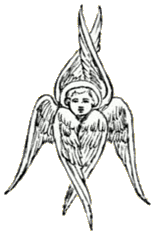Saint Bonaventure Life
St. Bonaventure was Italian
born in Giovanni di Fidanza Italy in the year 1221 and died on July 15, 1274 in
Lyon, Lyonnais, Kingdom of Arles. St. Bonaventure joined the seventh Minister
General of the Order of Friars Minor. He was nominated Archbishop of York by
Pope Clement IV, but he begged not to be forced to accept that dignity. Pope
Gregory X obliged him to take upon himself a greater one, that of Cardinal and
Bishop of Albano, one of the six suffragan Sees of Rome.
Before his death he abdicated his
office of General of the Franciscan Order. He died while
he was assisting at the Second Council of Lyons, on July
15, 1274.
St.
Bonaventure:
- Medieval

- Franciscan

- Scholastic Theologian

-
Philosopher

St. Bonaventure received the name of Bonaventure in
consequence of an exclamation of St. Francis of Assisi,
when, in response to the pleading of the child’s mother,
the Saint prayed for John’s recovery from a dangerous
illness and foreseeing the future greatness of the
little John, cried out
“O Buona ventura” O good fortune!
After
the
spirit
that
filled
him and
his
writings,
he was
initially
called
the
Devout
Doctor.
But in
more
recent
centuries
he has
been
known as
the
Seraphic
Doctor
after
the
“Seraphic
Father”,
St.
Francis
because
of the
truly
Franciscan
spirit
he
possessed.
At the
age of
twenty-two,
St.
Bonaventure
entered
the
Franciscan
Order.
Having
made his
vows, he
was sent
to Paris
to
complete
his
studies
under
the
celebrated
doctor
Alexander
of
Hales,
an
Englishman
and a
Franciscan.
After
the
latter’s
death he
continued
his
course
under
his
successor,
John of
Rochelle.
In Paris
he
became
the
intimate
friend
of the
great
St.
Thomas
Aquinas.
Bonaventure
received
the
degree
of
Doctor,
together
with St.
Thomas
Aquinas,
ceding
to his
friend
against
the
latter
inclination,
the
honor of
having
it first
conferred
upon
him.
Like St.
Thomas
Aquinas,
he
enjoyed
the
friendship
of the
holy
King,
St.
Louis.
At the
age of
thirty-five
he was
chosen
General
of his
Order
and
restored
a
perfect
calm
where
peace
had been
disturbed
by
internal
dissensions.
He did
much for
his
Order.
He wrote
500
sermons
and
composed
The Life
of St.
Francis.
He also
assisted
at the
translation
of the
relics
of St.
Anthony
of
Padua.
Many
writings
believed
in the
Middle
Ages to
be his
are now
collected
under
the name
Pseudo-Bonaventura.
Some of
St.
Bonaventure
written
works:
- The Mind’s Road to God

- Psalter of the Blessed
Virgin Mary

- Journey of the Mind to God

-
Perfection of Life

-
Soliloquoy

-
The Threefold Way

Bonaventure
was
canonized
on April
14, 1482
by Pope
Sixtus
IV in
Rome and
declared
a Doctor
of the
Church
in the
year
1588 by
Pope
Sixtus
V.
St.
Bonaventure
attributes:
-
Cardinals hat on a bush

- Ciborium

- Holy Communion

-
Cardinal in Franciscan robes, usually reading or
writing

 |
 |
True Account
Seraphim Angel
On Earth |

September 14, 1224
St. Bonaventure, in his Life of St. Francis, describes St. Francis receiving his Stigmata from a Seraphim Angel on September 14, 1224. This took
place at La Verna, Italy on a mountainside, with other monks nearby, when St. Francis was praying focusing especially on the crucifixion because that day was the Feast of the Exultation of the Holy Cross. While praying St. Francis Assisi saw one of the highest-ranking angels in creation approaching him. St. Bonaventure wrote “a seraph with six fiery and shining wings descend from the height of heaven. And when in swift flight the seraph had reached a spot in the air near the man of God, there appeared between the wings the figure of a man crucified, with his hands and feet extended in the form of a cross and fastened to a cross. Two of the wings were lifted above his head, two were extended for flight and two covered his whole body”. St. Bonaventure continued “mysterious and intimate conversation” occurred between the seraph and St. Francis, leaving St. Francis with “aglow with seraphic love in his soul”.
After the encounter ended, St. Francis discovered that the seraph had miraculously given him wounds reminiscent of those that Jesus Christ suffered while sacrificing himself for the world's sins in the cross. Those types of wounds, when given supernaturally, have come to be called stigmata.
St. Francis was the first person in recorded history to receive the stigmata.
St. Bonaventure wrote “it left marks on his body like those of the crucified as if the impression of a seal had been left on heated wag. The figures of the nails appeared immediately on his hands and feet. The heads of the nails were inside his hands but on top of his feet with their points extending through to the opposite side. His right side too showed a blood-red wound as if it had been pierced by a lance, and blood flowed frequently from it. Because of this new and astounding miracle unheard of in times past, St. Francis came down from the mountain a new man adorned with the sacred stigmata, bearing in his body the image of the crucified not made by a craftsman in wood or stone, but fashioned in his members by the hand of the living God”.
This is all true.

St. Bonaventure served during the same century as a leader in the Franciscan religious order that was founded by St. Francis.
Two other pictures of St. Bonaventure.

|